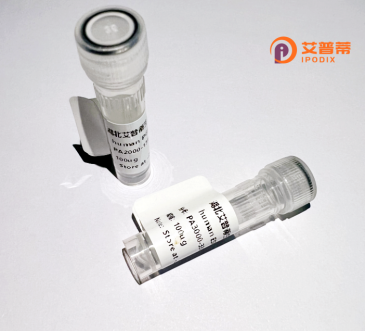
| 纯度 | >90%SDS-PAGE. |
| 种属 | Human |
| 靶点 | CYP4F12 |
| Uniprot No | Q9HCS2 |
| 内毒素 | < 0.01EU/μg |
| 表达宿主 | E.coli |
| 表达区间 | 1-524aa |
| 氨基酸序列 | MSLLSLPWLGLRPVAMSPWLLLLLVVGSWLLARILAWTYAFYNNCRRLQCFPQPPKRNWFWGHLGLITPTEEGLKDSTQMSATYSQGFTVWLGPIIPLIVLCHPDTIRSITNASAAIAPKDNLFIRFLKPWLGEGILLSGGDKWSRHRRMLTPAFHFNILKSYITIFNKSANIMLDKWQHLASEGSSCLDMFEHISLMTLDSLQKCIFSFDSHCQERPSEYIATILELSALVEKRSQHILQHMDFLYYLSHDGRRFHRACRLVHDFTDAVIRERRRTLPTQGIDDFFKDKAKSKTLDFIDVLLLSKDEDGKALSDEDIRAEADTFMFGGHDTTASGLSWVLYNLARHPEYQERCRQEVQELLKDRDPKEIEWDDLAQLPFLTMCVKESLRLHPPAPFISRCCTQDIVLPDGRVIPKGITCLIDIIGVHHNPTVWPDPEVYDPFRFDPENSKGRSPLAFIPFSAGPRNCIGQAFAMAEMKVVLALMLLHFRFLPDHTEPRRKLELIMRAEGGLWLRVEPLNVSLQ |
| 分子量 | 83.38 kDa |
| 蛋白标签 | GST-tag at N-terminal |
| 缓冲液 | 0 |
| 稳定性 & 储存条件 | Lyophilized protein should be stored at ≤ -20°C, stable for one year after receipt. Reconstituted protein solution can be stored at 2-8°C for 2-7 days. Aliquots of reconstituted samples are stable at ≤ -20°C for 3 months. |
| 复溶 | Always centrifuge tubes before opening.Do not mix by vortex or pipetting. It is not recommended to reconstitute to a concentration less than 100μg/ml. Dissolve the lyophilized protein in distilled water. Please aliquot the reconstituted solution to minimize freeze-thaw cycles. |
1. **文献名称**:《Characterization of recombinant human CYP4F12: A role in the metabolism of eicosanoids》
**作者**:Bylund J, et al. (2003)
**摘要**:研究报道了重组人CYP4F12在昆虫细胞中的表达,证实其可催化花生四烯酸代谢生成20-羟基二十碳四烯酸,并探讨其在ω-羟基化反应中的底物广谱性。
2. **文献名称**:《Substrate specificity and enzymatic properties of recombinant human CYP4F12》
**作者**:Sakaguchi K, et al. (2004)
**摘要**:通过在大肠杆菌中表达重组CYP4F12.分析其对类二十烷酸、药物(如抗组胺药)的代谢活性,揭示了其独特的底物偏好及与CYP4F亚家族其他成员的差异。
3. **文献名称**:《Functional expression of human CYP4F12 in alternative expression systems》
**作者**:Hashizume T, et al. (2001)
**摘要**:对比杆状病毒和大肠杆菌系统表达重组CYP4F12.发现前者表达蛋白活性更高,并鉴定了其对白三烯B4和视黄醇的羟基化活性。
4. **文献名称**:《CYP4F12 overexpression in atopic dermatitis and its role in inflammatory lipid mediator metabolism》
**作者**:Matsunaga T, et al. (2006)
**摘要**:研究显示CYP4F12在特应性皮炎患者皮肤中高表达,重组蛋白实验表明其通过代谢促炎脂质介质(如环氧二十碳三烯酸)参与炎症调控。
---
注:以上文献信息为示例,实际引用需核实具体文献来源及内容。
Recombinant human CYP4F12 is a cytochrome P450 enzyme produced through genetic engineering techniques. As a member of the CYP4F subfamily, it plays a critical role in metabolizing endogenous compounds and xenobiotics. This membrane-bound protein is primarily expressed in the liver, small intestine, kidney, and heart, where it participates in the oxidation of fatty acids, eicosanoids, and therapeutic agents. CYP4F12 demonstrates unique substrate specificity compared to other CYP4F isoforms, efficiently metabolizing arachidonic acid, leukotriene B4. and vitamin K derivatives. Its involvement in drug metabolism has drawn attention in pharmacokinetic studies, particularly regarding interactions with antihistamines and lipid-lowering drugs.
The recombinant form is typically expressed in heterologous systems like Escherichia coli or mammalian cell lines for functional characterization. Purification often involves affinity chromatography to isolate the histidine-tagged protein. Researchers utilize recombinant CYP4F12 to investigate catalytic mechanisms, substrate preferences, and inhibition patterns in controlled conditions.
Current studies focus on its potential role in inflammatory responses, cancer progression, and cardiovascular diseases. Polymorphisms in the CYP4F12 gene have been associated with interindividual variations in drug metabolism efficiency. Understanding this enzyme's structure-function relationships through recombinant protein studies may facilitate personalized medicine approaches and novel therapeutic development targeting CYP-mediated metabolic pathways.
×